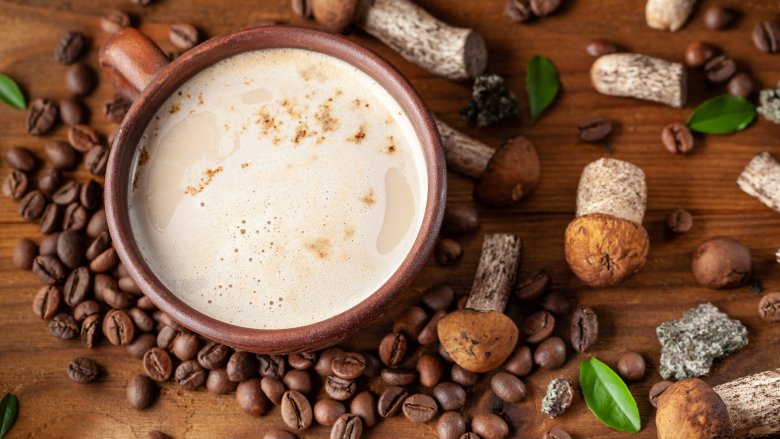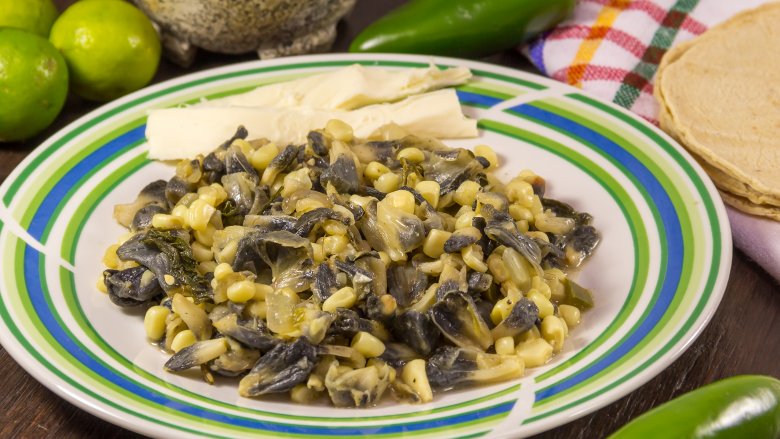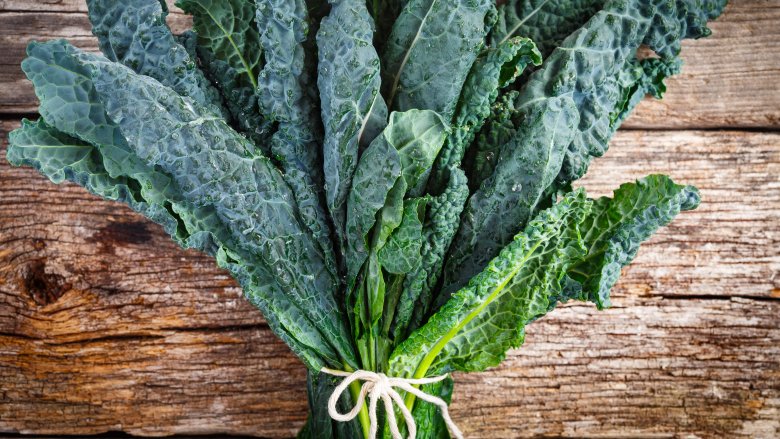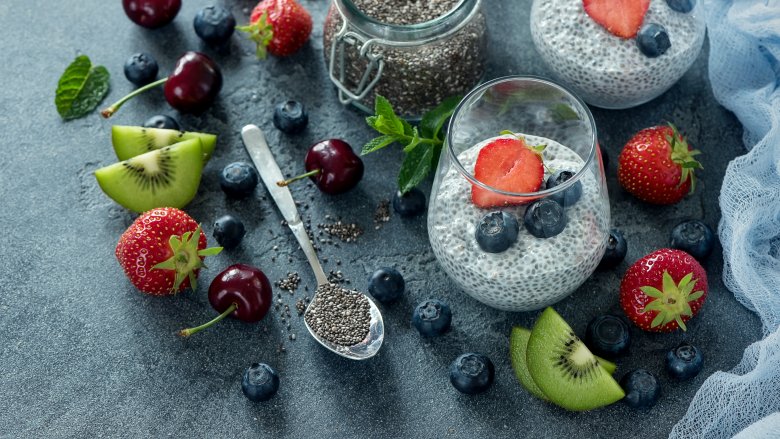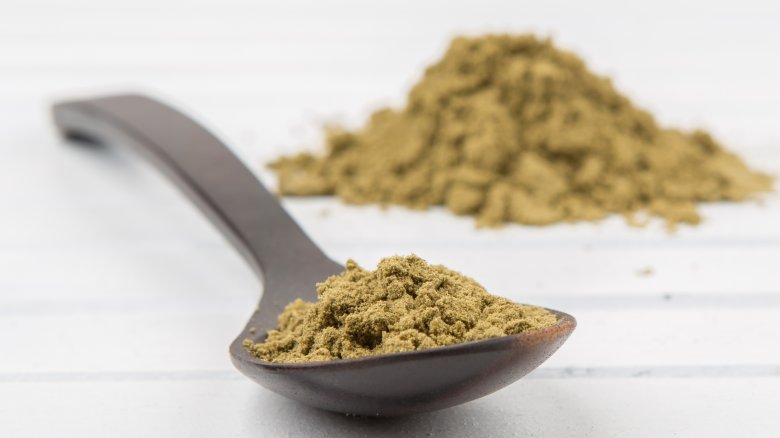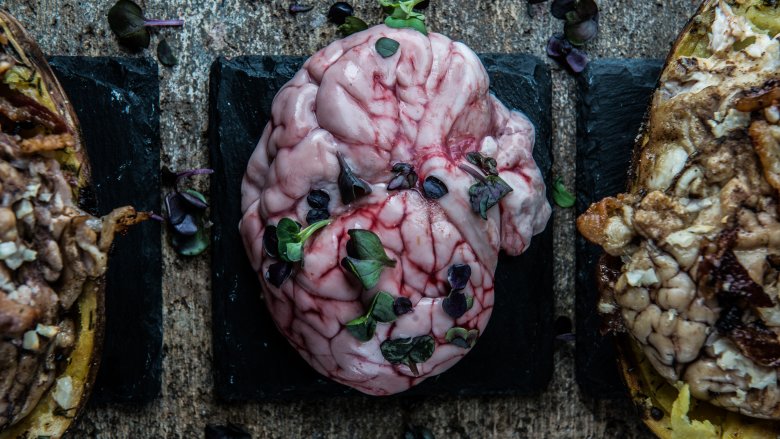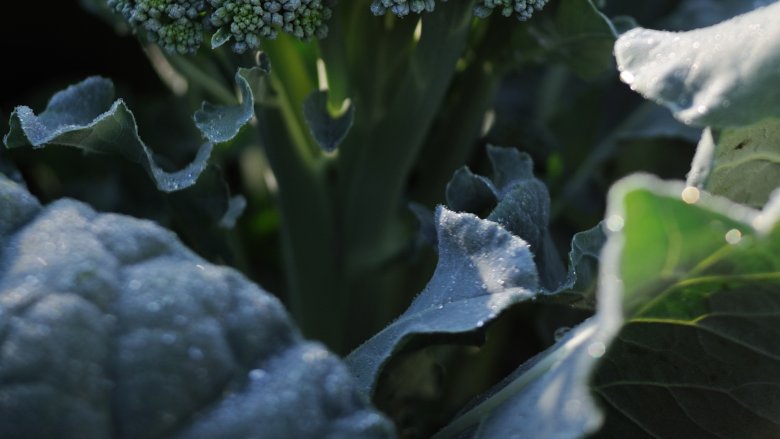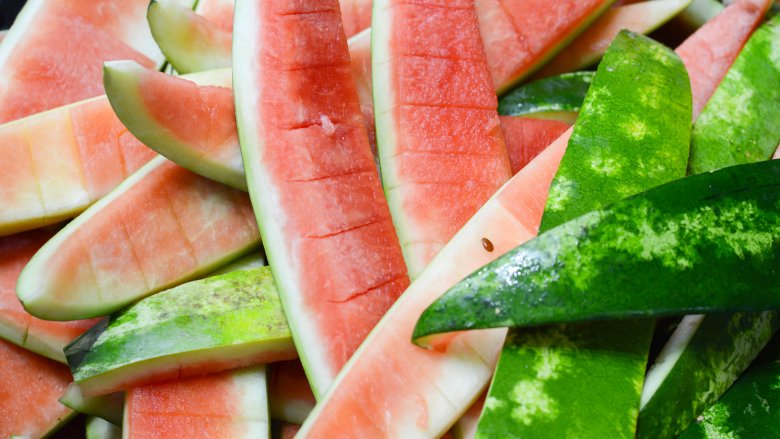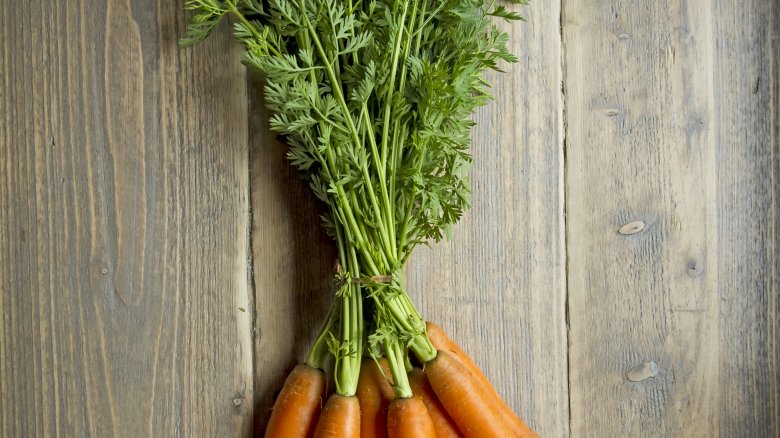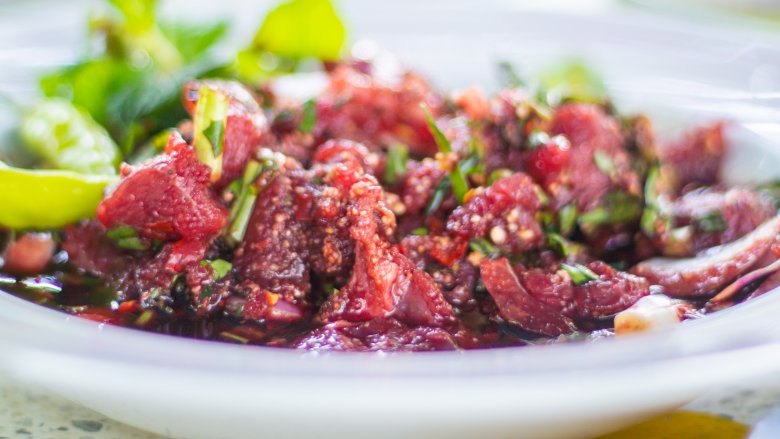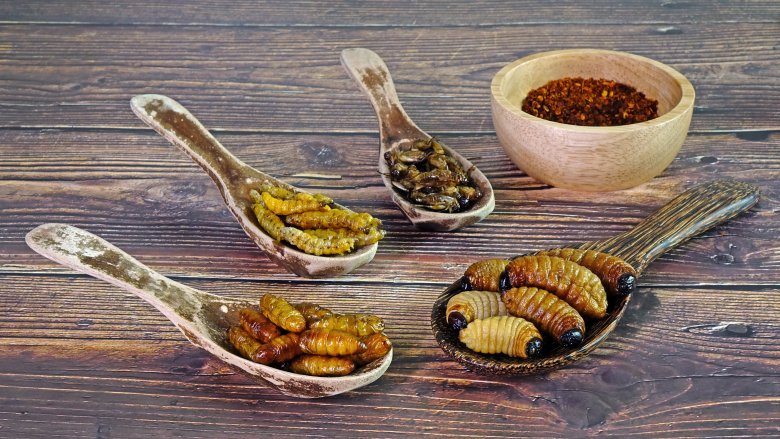Things People Eat Now That Weren't Considered Food In The Past
Even to our more recent ancestors, the modern American plate would likely be unrecognizable. Gone are the TV dinners and congealed jello salads. In their place are raw fish poke bowls and flaxseed smoothies.
America's diet has changed dramatically over the last few decades. We're eating more chicken and less beef. We're drinking less whole milk but chowing down on more cheese. We're consuming more calories overall and snacking more frequently.
As our eating habits continue to evolve at a quickening pace, we've begun gobbling down foods that previously, weren't even recognized by Americans as edible.
Of course, just because it's taken the U.S. so long to catch on doesn't mean that other international civilizations weren't already gobbling down these goodies. Many — like insects and blood — have been a part of people's regular diets for thousands of years.
Here are just a few of the things Americans eat now, that we didn't consider food in the past.
Corn fungus
Before it began to be seen as a delicacy, corn smut — aka "devil's corn" — was little more than a feared crop disease in the U.S. The smut, caused by a fungus known as Ustilago maydis, grows on ears of corn in puffy, grey clouds. For corn farmers, smut was a curse, infecting crops and rendering them unsellable.
In Central Mexico, on the other hand, corn smut has been considered a delicacy enjoyed since ancient times. Throughout the country, corn smut or huitlacoche (pronounced weet-la-COH-cheh) is sold in markets and used soups, enchiladas, sauces, and other traditional dishes.
It was only in the last couple decades that chefs and foodies outside of Mexico began to see corn smut as something beyond a scourge. Its slow but steady transformation into a gourmet ingredient was kicked off by Josefina Howard, founder and the first chef-owner of Rosa Mexicano in New York. It was this chef who served a hit, all-huitlacoche dinner at the James Beard Foundation, spearheading the underground corn smut movement in the U.S.
Despite government and corn farmer efforts to outlaw corn smut, the "Mexican truffle" has found its way onto the menu at top restaurants. Turns out, the bulbous grey growth us quite tasty, with a rich, smoky flavor reminiscent of mushrooms and raw corn. And, it's good for you — corn smut is full of protein, minerals, and other nutrients.
Activated charcoal
Long before the the pitch-black food trend swept across Instagram, activated charcoal was used in hospitals and emergency rooms as an antidote for overdoses. So how did this long-time medicine become a nationwide food trend? To understand the transformation, let's take a look at what activated charcoal is and its purported benefits.
Not to be confused with the charcoal you use in your grill, activated charcoal or carbon is a fine black powder made by charring coconut shell into ash. The charcoal is "activated" by processing the ashes at extremely high temperatures, which alters the charcoal's internal structure. The resulting product is more porous than regular charcoal and safe for consumption.
When chefs, bartenders, and baristas first got their hands on activated charcoal in the late 2010s, they started infusing it into everything from pizza and ice cream to lattes and cocktails. Claims that activated charcoal can boost energy, cure hangovers, and debloat bellies grew the new ingredient into a craze, though the only benefit that has been really proven is activated carbon's power to detoxify.
So, should you eat activated charcoal foods? That's something you should discuss with your doctor. But there's no denying it looks cool.
Kale
After witnessing the epic rise of kale, it can be hard to remember a time when the leafy green vegetable wasn't a staple in farm-to-table salads, green smoothies, and Blue Apron recipe boxes.
But only a couple of decades ago, most Americans eschewed kale in favor of iceberg lettuce. Back then, the largest purchaser of kale in the U.S. was Pizza Hut, who used the leaf as a garnish to decorate their salad bars.
Americans started seeing as kale as more than a garnish in the early 2010s, when a PR firm My Young Auntie was hired by the American Kale Association to make kale trendy. Headed by Oberon Sinclair, My Young Auntie used her connections in the NYC food and fashion industries to introduce kale to top New York restaurants and emblazon it into onto hip t-shirts. The increasingly health conscious American public embraced kale for all it's now-well-known nutritional benefits, and Time named kale one of the country's top food trends in 2012.
Chia seeds
Speaking of trendy superfoods that got their start as decorations, chia seeds were best know for their part in a Chia Pet package only a few decades ago. Marketed with the iconic Ch-Ch-Chia jingle during the '80s and '90s, the tiny seeds sprouted into green hair on terracotta "pets," including animals, presidential candidates, and Simpson's characters.
Of course, long before chia seeds were being blossomed on Chia Pets, they were an important part in the ancient Aztec diet. Rather than growing them into pretend pets, Aztec warriors gobbled down chia seeds to harness their supernatural powers.
From Aztec warrior fuel and hairdos on clay animal toys, chia seeds were reborn as a hip, Instagram-worthy food in early 2010s. That's when the health food industry unleashed chia groceries, snacks, and drinks onto American consumers. Now, the U.S. is the largest chia seed consumer in the globe, importing more than 15,000 tons annually. The magical seeds have been elevated to the status of superfood due their rich omega-3, fiber, and protein content, and thanks to claims like reducing appetite and weight.
Hemp
Hemp, a low-THC variety of the plant cannabis sativa, has played an important part in U.S. history — though traditionally outside the kitchen. Hemp fiber was woven into the U.S. Constitution, early U.S. flags, and virtually all ship sails before the last century. In the 20th century, however, the hemp industry declined thanks to hits like The Marihuana Tax Act of 1937 and the passage of The Controlled Substances Act.
Hemp was illegal for many years before the FDA started allowing manufacturers to import dietary hemp products. The government's lift of some hemp restrictions paved the way for the country's thriving hemp foods retail industry. At specialty food stores and chains like Trader Joe's and Whole Foods, you can shop hemp-based products like hemp milk, hemp seed butter, hemp wellness bars, hemp seed burgers, and more.
From roots as a fiber for flags, hemp has come to be celebrated as a nutrition-packed food. The plant boasts a high protein, unsaturated fat, and fiber content, in addition to being associated with health benefits like reduced inflammation and lessened risk of cardiovascular disease.
Brains
Sure, they've been the preferred dish of zombies for centuries. But brains tended to make living, breathing Americans squeamish up until recently. (Remember the scene in Indiana Jones and the Temple of Doom when Kate Capshaw is served chilled monkey brain and she faints?)
Over the last 20 years or so, top chefs have become increasingly eager to experiment with brains and other offal — and diners are lining up to give these brave new dishes a try. In 1998, chef Mario Batali famously started dishing out calf's brain ravioli at Babbo in NYC. The recipe was so popular, it earned a permanent place on the restaurant's menu.
As chef and food writer Chris Cosentino explained to Bloomberg, eating brains is so common today, "It's stopped being cool." Now, you can sample brain at restaurants around the country, from fried calf's brains at Hojoko in Boston to "brain-aise" dip of Cosentino's Cockscomb in San Francisco. Apparently, brains have a creamy, firm texture reminiscent of fish roe.
Cactus water
Conjuring images of dry, hot deserts, prickly pear cactus plants may have seemed like an unlikely source of hydration before the cactus water trend gripped the country.
Prickly pear cactuses have long been eaten in Mexico, where it is also thought of as a hangover cure. Bottled cactus water was unleashed into the American marketplace in the late 2010s, where it quickly took off due to its many purported benefits. Cactus water is said to contain natural electrolytes, vitamins, and minerals, in addition to taurine — a rare antioxidant that can help heal muscle damage that occurs during exercise. The all-natural drink has about half the calories and half the sugar as coconut water, which — combined with the nutrients and healing properties — have made it a particularly attractive hydration choice among the health conscious masses. Of course, it helps that cactus water is super refreshing and pleasantly fruity tasting, too.
Broccoli and cauliflower stalks and leaves
Just as the rise of nose-to-tail cooking has changed the way we thought about brains and other offals, the root-to-stem movement has transformed non-traditional parts of vegetables and fruits from scraps to food.
For generations, much of the American mainstream tossed the leaves, stems, stalks, and rinds of vegetables away as inedible or undesirable. The root-to-stem movement aims to teach us that these parts of the vegetable are indeed edible — and quite delicious and nutritious at that! The practice reduces food waste, saves money, and helps you get the most out of your produce.
The stalks and leaves of both broccoli and cauliflower are among the many vegetable parts commonly chopped off and thrown away. However, the stalks of both plants are tasty and very filling, and can be cooked along with the plants' crowns. In addition, broccoli leaves can be mixed into salads and stir-frys, while cauliflower leaves are scrumptious when roasted with a bit of oil and spices.
Watermelon rinds
Another awesome product of the root-to-stem movement? Watermelon rinds.
Summer after summer, we have devoured the juicy pink flesh of the watermelon before tossing away the bright green peel. The loss was ours — as it happens, the watermelon rind is not only edible, but packed with vitamins B and C. Recent research has found that watermelon rind is an excellent source of the non-essential amino acid citrulline, which may help improve circulation in addition to offering other benefits.
To enjoy watermelon rind, you can eat it as-is, or try pickling it. Watermelon rind pickles are tart and crunchy, and taste great when pickled with lemons, sugar, salt, and hot sauce. Alternatively, you can blend the rind with strawberries and chia seeds for a sweet and refreshing smoothie. You can also chop the watermelon rind up and cook it like you would a vegetable into a savory stir-fry.
Carrot greens
Even today, it's hard to find carrots that still have their greens on them. For the last few years, there was a rumor circulating that carrot tops were poisonous. The falsity was largely perpetuated by a confusing article titled "The Toxic Salad" published by The New York Times in 2009.
In fact, carrot greens are not only not poisonous, they're a good source of vitamin C, calcium, and potassium. And as many acclaimed American chefs are realizing, the fibrous stems add zest and nutrients to cooking.
You can eat carrot greens raw in a salad, though the taste may be somewhat bitter. A more popular idea is to chop up carrot greens and use them as you would an herb. Try using finely chopped carrot tops as a garnish or blending greens with other other fresh herbs into a pesto or tabbouleh. You can also cook the carrot stems in soups and stock to add flavor.
Blood
As Americans become more culinarily adventurous, we're opening up our kitchens to ingredients we once found icky — like blood, for example. Blood has been consumed by countries around the world for centuries — consider morcilla sausage in Spain or boudin noir in France — but never really made its way into America's kitchens before now.
In addition to the squeamishness of American diners, blood may have not taken off as a delicacy yet because it's illusiveness. Many people believe blood is illegal; in fact, blood is often just a challenge to come by. This may be due to lack of demand, but also because many slaughterhouses sell blood to rendering businesses.
Increasingly, top chefs who can get their hands on the liquid are serving up blood at their restaurants. Creative cooks are folding the substance into unique dishes like black pudding waffles, blood-infused broths, and pork blood stew. They prize blood for its richness and flavor, in addition to its high protein, iron, and vitamin content.
Insects
Though insects have been consumed in countries around the world for thousands of years, Europeans and European settlers in America have historically turned up their nose at the idea of eating bugs until recently. The entomophagy or edible insects movement has taken off within the last five years, as a growing body of U.S. consumers are changing their perspective on insects from creepy, crawly critters to the healthy, sustainable food source that just might save the planet. Nowadays, grasshopper tacos fly of the grills at Mariners games and top chefs whip up gourmet dishes with tarantulas, mealworms, and ants.
Chef Joseph Yoon, executive director at Brooklyn Bugs, predicts most Americans will be eating bugs within 10 years. And they'd be wise to do so — some insects are like superfoods, full of protein, fiber, healthy fats, and essential minerals. With more 1,900 edible insect species on the earth, insects are a sustainable, incredibly eco-friendly protein source requiring much less resources than raising livestock.
